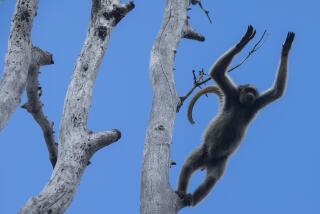Fruit-Eating Tree Dweller Dates Back 53-Million Years : Wyoming Badlands Yield Oldest True-Primate Fossil
- Share via
The oldest fossil of a “true primate” has been unearthed from the sediment of the Yellowstone River basin in the Wyoming Badlands.
The 53-million-year-old fossils, a total of eight teeth on three segments of jawbone, belonged to a fruit-eating, tree-dwelling primate called Cantius torresi. Cantius weighed 2 to 2 1/2 pounds and had wide eyes, wooly fur, a long tail and a muzzle like a fox.
The fossils were found in the summer of 1984 by University of Michigan graduate student Victor Torres. The discovery was reported in the most recent issue of the British journal Nature by Philip Gingerich of the university.
The new fossils bear characteristics of two previously unconnected primate families--lemurs, nocturnal mammals confined to Madagascar, and tarsiers, nocturnal mammals of Southeast Asia.
“Ancestors of both of these primates are much better known in the (geological) period immediately after this find,” Gingerich said in a telephone interview. “The importance of this new find is that a slightly older fossil combines features of the teeth of both of the other species.”
In particular, the teeth are small and relatively broad, characteristics of the tarsier family not found in the lemur family. The positions of the cusps on the teeth, however, are like those of lemurs rather than tarsiers.
Anthropologists had already traced human primates back 5 million years, apes 35 million years, and monkeys 40 million years. Ancestors of the lemur and tarsier had been dated to 52 million years ago.
“While (the new discovery) doesn’t push our ancestry back very far,” Gingerich said, “it helps clarify the time of origin of primates leading up to us.”
It is not yet clear, however, if the fossil represents a direct ancestor of humans. “It’s generalized enough, and old enough, to be an ancestor,” Gingerich said. “But we normally wouldn’t expect to find such an ancestor in North America. We would obviously like to see something similar discovered in Africa.”
Gingerich and his students have been gathering fossils at the Wyoming site for 11 years. “These teeth were among 15,000 to 20,000 fossils we’ve collected there. . . . Torres found the little teeth lying in the rock surface where they were exposed by weathering.”
More to Read
Sign up for Essential California
The most important California stories and recommendations in your inbox every morning.
You may occasionally receive promotional content from the Los Angeles Times.













